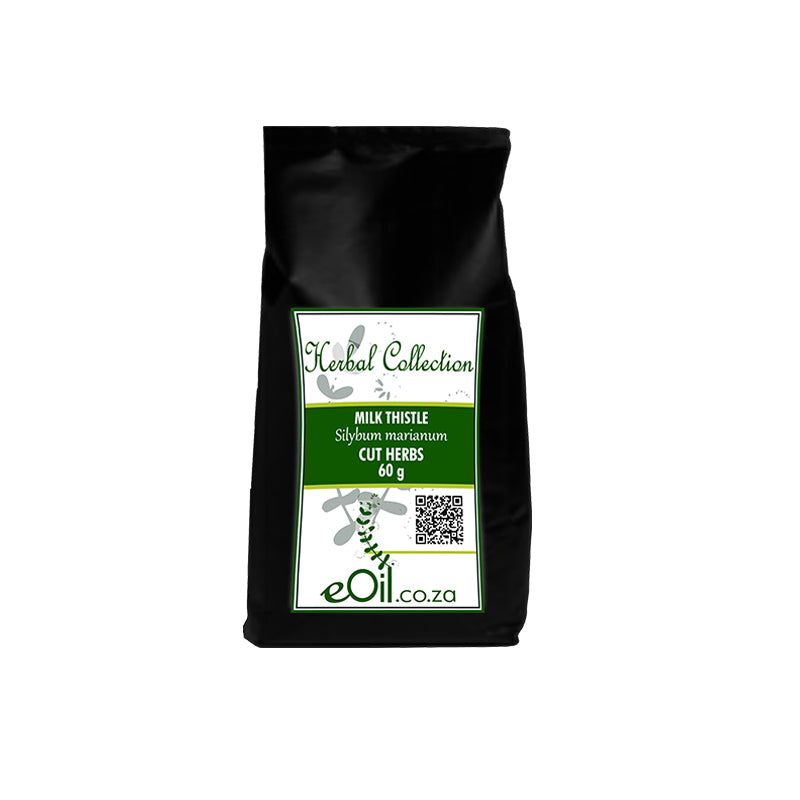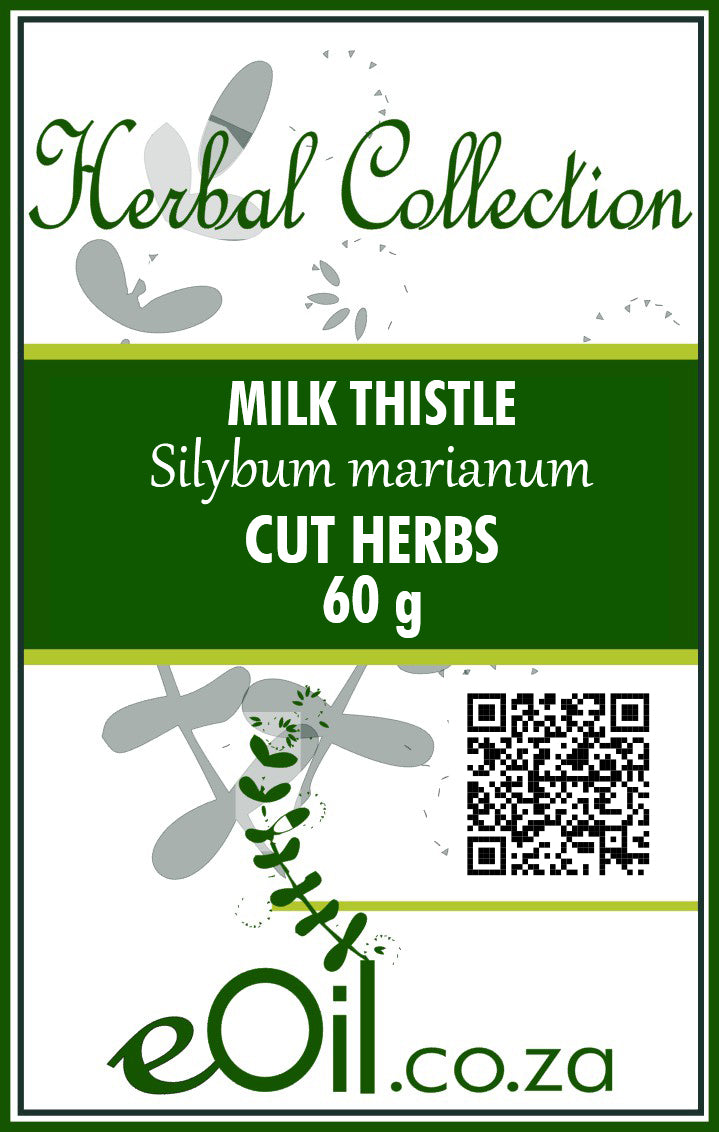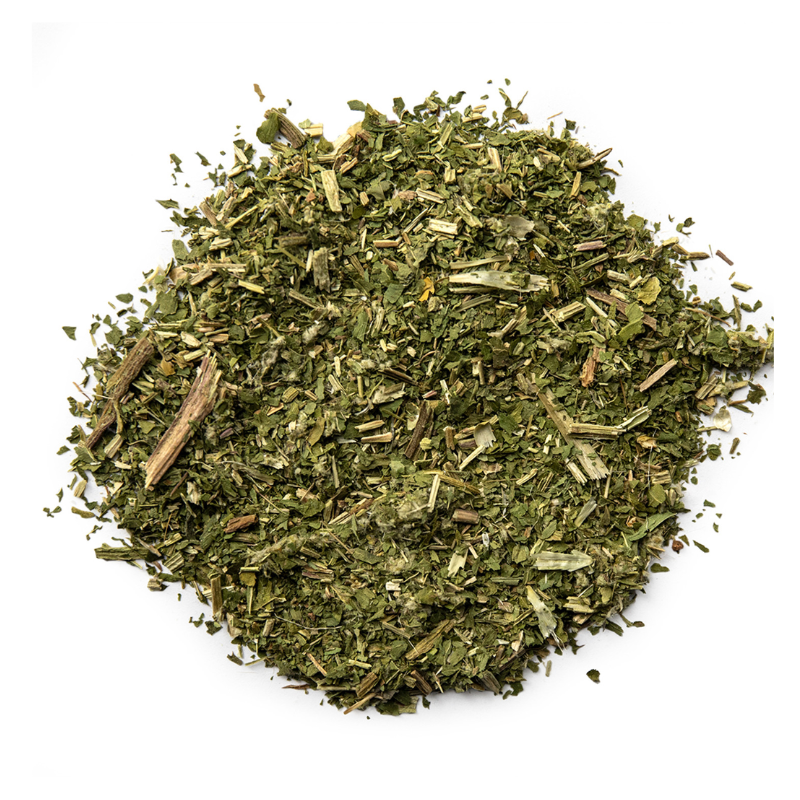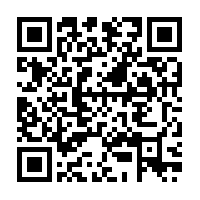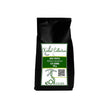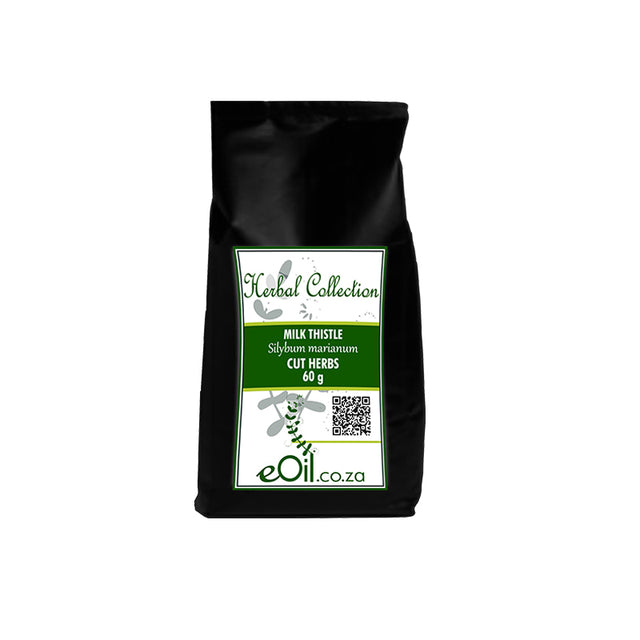Milk Thistle Dried Herb Cut - Herbal Collection
Milk Thistle Dried Herb Cut - Herbal Collection - 60 GR is backordered and will ship as soon as it is back in stock.
Description
Description
Understanding Mother Tinctures & Glycerines
Milk Thistle vs Blessed Thistle | comparaison and uses
MilkThistle Dried Herb Cut (Silybum marianum) consists of the cut leaves and stems of this Mediterranean plant, valued for its unique flavonoid compounds like silymarin.
Traditionally used in teas for gentle, natural liver and digestive support, it is also known for its antioxidant content.
Suitable for herbal infusions or blends, this vegan, naturally caffeine-free herb is ethically sourced and ideal for daily wellness routines
TRADITIONALLY USED FOR
Milk thistle (Silybum marianum), a flowering herb native to the Mediterranean, is widely recognized for its potential health benefits, particularly due to its active compound, silymarin. Below is a summary of its key benefits:
Key Benefits of Milk Thistle
1. Liver Health
- Milk thistle is best known for its liver-protective properties. Silymarin helps protect liver cells from toxins, supports liver regeneration, and reduces inflammation and oxidative stress.
- It has been used as a complementary therapy for liver conditions such as cirrhosis, hepatitis, alcoholic liver disease, and non-alcoholic fatty liver disease.
Some studies suggest it may improve liver enzyme levels and protect against damage from toxins like alcohol and certain medications.
2. Antioxidant and Anti-inflammatory Effects
Silymarin acts as a potent antioxidant, neutralizing free radicals and reducing oxidative stress. These properties contribute to its benefits for liver health and other conditions like inflammation-related diseases.
3. Diabetes Management
- Milk thistle may help reduce blood sugar levels and improve insulin sensitivity in people with type 2 diabetes. It has also been linked to improved cholesterol levels in diabetic patients.
- However, more research is needed to confirm these effects in broader populations.
4. Brain Health
- Its antioxidant and anti-inflammatory properties may protect neurons from damage, potentially slowing age-related cognitive decline. Preliminary research suggests it could reduce amyloid plaque buildup associated with Alzheimer’s disease.
5. Bone Health
- Studies suggest that milk thistle may stimulate bone mineralization, which could help prevent osteoporosis, especially in postmenopausal women. However, human studies are limited.
6. Cancer Support
- Preclinical studies indicate that milk thistle might inhibit the growth of cancer cells in various types of cancer (e.g., prostate, breast, cervical). It may also enhance the effectiveness of chemotherapy while reducing its side effects.
7. Skin Health
- Milk thistle’s anti-inflammatory and antioxidant properties may benefit skin conditions like acne by reducing oxidative stress and inflammation.
8. Heart Health
- By lowering LDL ("bad") cholesterol levels, milk thistle may support heart health, particularly in people with diabetes. However, its effects on non-diabetic individuals remain unclear.
9. Immune System Support
- Some evidence suggests that milk thistle may strengthen the immune response and reduce chronic inflammation linked to immune system disorders
Safety and Side Effects
Milk thistle is generally well-tolerated but may cause mild side effects such as nausea, upset stomach, or allergic reactions in sensitive individuals (e.g., those allergic to ragweed or daisies).
Pregnant or breastfeeding individuals and those on medications should consult a healthcare provider before use.
While promising, many of these benefits require further research to confirm their efficacy in humans.
INFORMATION
Source : http://www.wikiphyto.org/wiki/Chardon-Marie
Reference on http://www.wikiphyto.org
Translation in English by Google Translate (go to the page of the source linked | on Chrome cellphones go on the 3 dots on the top right and select translate in your preferred language | on laptop right click your mouse and select option translate when hoovering on the page
plant name
Milk thistle , milk thistle (English), Mariendistel (German)
International Latin denomination
Silybum marianum (L.) Gaertn. (formerly Carduus marianus )
botanical family
Asteraceae
Description and habitat
- Biennial plant growing up to 1.50 m in height
- Leaves with white marbled blades along the veins, the teeth of which end in very sharp yellow tips
- Large purple-mauve flower heads 3 to 8 cm, with spiny bracts
- Wastelands of Southern Europe, Northern Africa, Western Asia
History and tradition
- According to popular belief, the white marks on the leaves come from the milk of the Virgin breastfeeding the child Jesus.
Parts used
- Fruit = rough black achene, 6 to 7 mm by 3, with a remnant of the floral crown in the form of a light yellow cylindrical scale
Dosage forms available
- Carduus marianus fruit tincture
- Fluid extract
- Dry extract
- Légalon® ( Silybum marianum fruit, corresponding to silymarin 70 mg)
- EPS
Usual dosages
- 12-15 grams of herbal drug (fruit or fruit powder)
- Legalon®: 2 tablets, 2 to 3 times a day
Composition
Main components of the plant
- Flavonolignans responsible for the activity (mixture of flavanonic derivatives called silymarin , 1.5 to 3% of the drug) whose major components are silybin (= silibin = silybinin , formed of two stereoisomers A and B), silydianin and silychristin and their many stereoisomeric derivatives ( isosilybin , dihydrosilybin )
- Flavonoids : quercetol , taxifolin , dihydrokaempferol , apigenin , naringin , eriodyctiol , chrysoeriol
- Phenolic derivatives
- Tocopherol and sterols : campesterol , sitosterol , stigmasterol
- Lipids 20 to 30%, proteins, sugars
Main components of buds or young shoots
Main components of essential oil
Properties
Plant properties
- Hepatoprotective by flavonolignans [1] , [2] , [3] , [4] , [5] , activities related to various functions of receptors and transporters located in cell membranes, modulation of TNF-alpha and selectins, antioxidant properties and inhibition of lipoxygenase pathway, inhibition of inducible nitric oxide synthase iNOS, nuclear factor kappa B and reduction of collagen synthesis, DNA and RNA mediated effects [6]
- Silymarin acts by two mechanisms:
- It is a membrane stabilizer (it inhibits the membrane transport systems of hepatocytes, making the absorption of toxins more difficult, inhibits the peroxidation of lipids [7] and increases the uptake of free radicals produced by hepatotoxic substances); it contributes to the maintenance of the glutathione pool responsible for hepatic detoxification (phase 2 enzymes), reduces the increase in transaminases and alkaline phosphatases, protects against oxidative stress [8]
- It stimulates the activity of polymerase A, therefore increases the synthesis of ribosomal nucleic acids and the number of ribosomes in hepatocytes, which increases enzyme biosynthesis, protein synthesis and stimulates the capacity for hepatic regeneration
- Prevention and treatment of hepatotoxicity from carbon tetrachloride [9] , galactosamine [10] and phalloidin [11] , [12] , [13]
- Antidote for amanita phalloides poisoning [14] , a meta-analysis of 452 patients with amanita phalloides poisoning show a significant difference in mortality in favor of silibinin (mortality 9.8% vs. 18.3% with standard treatment, p <0.01) [15] , silibinin prevents the absorption of amatoxins from amanita phalloides by hepatocytes, thus protecting liver tissue, it stimulates DNA-dependent RNA polymerases, increasing RNA synthesis [16] , [17] , [18]
- Improved lifespan in cirrhosis [19]
- Antiviral against hepatitis C [20] , [21] , inhibits the RNA polymerase of the virus [22]
- Prevention of hepatocellular carcinoma by synergy Cynara scolymus , Silybum marianum , Cochlospermum angolense [23]
- Nephro-protective [24]
- The plant is also galactogenic [25] , [26] , [27] and anti-depressant
- Anti-cancer properties of silymarin [28] , anti-inflammatory properties and antimetastatic activity by modulation of specific proteins [29]
- Silymarin exerts anti-cancer activity through multiple mechanisms: initiation of carcinogenesis, promotion and progression. Its antimetastatic effect is notable. Numerous clinical studies show a reduction in the toxicity of chemotherapeutic agents in combination with silymarin [30]
- Silymarin inhibits the proliferation of tumor cells of various cancers:
- Of the prostate [31] , [32] , [33] , [34] , with inhibition of angiogenesis and angiogenesis regulatory molecules (VEGF former name of NO, VEGFR1, VEGFR2, phospho-Akt, HIF- 1α) ( flavonolignans : silybin A , silybin B , isosilybin A , isosilybin B ) [35]
- From the ovary [36]
- Breast [37]
- Lung [38]
- Skin [39]
- From the bladder [40] , [41]
- Decreases renal toxicity of cis-platin [42]
- Silymarin ( flavonolignan ) exhibits immunosuppressive effects [43] , [44] , [45]
- The combination with phosphatidyl-choline would increase the absorption and effectiveness of silymarin [46]
- Hypoglycemic effect [47]
- The oil extracted from the seeds, a by-product of the manufacture of silymarin , also has antioxidant properties [48]
Bud properties
Properties of essential oil
Directions
Indications of the whole plant (phytotherapy)
- Hepatitis and latent liver disease, steatosis, cirrhosis
- In viral hepatitis B or C, silymarin acts favorably on the elevation of transaminases and gamma-GTs, but not on the viral load [49]
- Prophylaxis and treatment of hepatic diseases caused by toxins (prevention of chemotherapy, protection of hepatic cells during cancer chemotherapy) [50]
- Protection against the toxic effects of phalloidin with better effects if the administration is prophylactic (so if the flavonolignans are absorbed before the phalloidin or any other toxicant)
- Cancer:
- Chemoprotection
- Silibinin therapy can target inhibition of proliferative pathways of various cancers through molecular mechanisms such as tyrosine kinase receptors, androgen receptors, STATs (signal transducer and activator of transcription), NF-kappaB, cell cycle regulatory pathways and apoptosis signaling pathways [51]
- Silibinin would have promising antineoplastic properties and would potentiate the effect of anti-cancer drugs (carcinomas of the skin, breast, lung, colon, bladder, prostate and kidney) [52]
- Some regressions are spectacular (for example of a hepatocarcinoma) [53]
- Nervous breakdown, stimulation of lactation
- Alcoholic infusions and extracts do not deliver enough silymarin to obtain a marked anti-hepatotoxic effect (insufficient effect of TM )
- Indeed, the usual dose is 12-15 g of drug, and the most marked effects were due to 140 mg of silymarin 3 times a day, i.e. 420 mg/day (if it is present at 2% in this sample would require 21 g of drug). Nevertheless, we can assume that the total extract will have an amplified activity compared to the flavanolignans alone .
- Usefulness in hepatic iron overload and hemochromatosis [54]
- Non-toxic (even at 20 g/kg in mice)
- In Belgium and Switzerland, silibinin (Legalon Sil®) is used in poisoning by amanita phalloides on experimental data (even if there is no real antidote for phalloides poisoning). Silibinin would act by limiting the intestinal absorption as well as the intra-hepatocyte transport of amatoxins and by stimulating RNA polymerase. A retrospective study of published cases would have found a statistical association between the use of silibinin and a reduction in mortality (as with N-acetylcysteine). Dosage: 5 mg/kg in 5% glucose IV over 2 hours, to be repeated every 6 hours for 6 days. Source: Belgian Poison Centerhttp://www.poisoncentre.be/article.php?id_article=33
- Silibinin would also be active on the replication of the hepatitis C virus [55].
- Potentialities in autoimmune diseases [43]
- Peak plasma silymarin is reached 2 to 6 hours after oral intake and its elimination half-life is approximately 6 hours [56] , [57]
Indications of the bud (gemmotherapy)
Specific indications of essential oil (aromatherapy)
Known or suspected mode of action
Usual formulations
Regulations
- French Pharmacopoeia list A (leaf, fruit)
Possible side effects and precautions for use
- No acute or chronic toxicity of silymarin (even at 20 g/kg in mice)
- Possibility of allergies to plants of the Asteraceae family
- Pharmacokinetic interactions:
- Monitor for possible drug interactions, silymarin decreases the activity of cytochrome P-450 (CYP) enzymes, UDP-glucuronosyltransferase (UGT) enzyme and reduces P-glycoprotein (P-gp) transport [58] , [59]
- Silymarin in particular reduces the activity of the CYP3A4 enzyme and the activity of uridine diphosphoglucuronosyl transferase (UGT1A6/9), it can therefore alter the hepatic metabolism of certain drugs, their pharmacokinetics and thus lead to increased toxicity [60 ] , but other works show that milk thistle extract has no significant influence on the activities of CYP1A2, CYP2C9, CYP2D6 or CYP3A4/5 [61].
- Avoid combination with chemotherapeutic treatments mainly metabolized by CYP3A4, it is advisable to make therapeutic windows
Bibliographic references
- Aller↑ Jacobs BP, Dennehy C, Ramirez G, Sapp J, Lawrence VA. Milk thistle for the treatment of liver disease: a systematic review and meta-analysis. Am J Med. 2002 Oct 15;113(6):506-15. PMID 12427501
- Aller↑ Polyak SJ, Oberlies NH, Sinner EI, Dahari H, Ferenci P, Pawlotsky JM. Silymarin for HCV infection. Antivir Ther. 2013;18(2):141-7. doi: 10.3851/IMP2402. PMID 23011959
- Aller↑ Polyak SJ, Morishima C, Lohmann V, Pal S, Lee DY, Liu Y, Graf TN, Oberlies NH. Identification of hepatoprotective flavonolignans from silymarin. Proc Natl Acad Sci US A. 2010 Mar 30;107(13):5995-9. doi: 10.1073/pnas.0914009107. PMID 20231449 full text
- Aller↑ Vargas-Mendoza N, Madrigal-Santillán E, Morales-González Á, et al. Hepatoprotective effect of silymarin. World Journal of Hepatology. 2014;6(3):144-149. doi:10.4254/wjh.v6.i3.144. Full Text
- Aller↑ Bahmani M, Shirzad H, Rafieian S, Rafieian-Kopaei M. Silybum marianum: Beyond Hepatoprotection. J Evid Based Complementary Altern Med. 2015 Oct;20(4):292-301. doi: 10.1177/2156587215571116. PMID 25686616
- Aller↑ Saller R, Melzer J, Reichling J, Brignoli R, Meier R. An updated systematic review of the pharmacology of silymarin. Forsch Complementmed. 2007 Apr;14(2):70-80. PMID 17464157
- Aller↑ Koch HP, Löffler E. Influence of silymarin and some flavonoids on lipid peroxidation in human platelets. Methods Find Exp Clin Pharmacol. 1985 Jan;7(1):13-8. PMID 3990442
- Aller↑ Asghar Z, Masood Z. Evaluation of antioxidant properties of silymarin and its potential to inhibit peroxyl radicals in vitro. Pak J Pharm Sci. 2008 Jul;21(3):249-54. PMID 18614420
- Aller↑ Mourelle M, Muriel P, Favari L, Franco T. Prevention of CCL4-induced liver cirrhosis by silymarin. Fundam Clin Pharmacol. 1989;3(3):183-91. PMID 2548940
- Aller↑ Hikino H, Kiso Y, Wagner H, Fiebig M. Antihepatotoxic actions of flavonolignans from Silybum marianum fruits. PlantaMed. 1984 Jun;50(3):248-50. PMID 6091165
- Aller↑ Desplaces A, Choppin J, Vogel G, Trost W. The effects of silymarin on experimental phalloidin poisoning. Arzneimittelforschung. 1975Jan;25(1):89-96. PMID 125090
- Aller↑ Frimmer VM, Kroker R. Phalloidin antagonists. 1. Effects of silybin derivatives on isolated perfused rat liver. Arzneimittelforschung. 1975 Mar;25(3):394-6. PMID 1174040
- Aller↑ Petzinger VE, Homann J, Frimmer M. Phalloidin antagonists. 2. Protective effect of disilybine in phalloidin poisoning of isolated hepatocytes. Arzneimittelforschung. 1975 Apr;25(4):571-6. PMID 1098677
- Aller↑ Professional information of the Swiss Compendium of Medicines [ https://compendium.ch/mpro/mnr/26689/html/fr#7850
- Aller↑ Saller R, Meier R, Brignoli R. The use of silymarin in the treatment of liver diseases. Drugs. 2001;61(14):2035-63. PMID 11735632
- Aller↑ Hruby K, Csomos G, Fuhrmann M, Thaler H. Chemotherapy of Amanita phalloides poisoning with intravenous silibinin. Hum Toxicol. 1983 Apr;2(2):183-95. PMID 6862461
- Aller↑ Carducci R, Armellino MF, Volpe C, Basile G, Caso N, Apicella A, Basile V. Silibinin and acute poisoning with Amanita phalloides. Minerva Anestesiol. 1996 May;62(5):187-93. PMID 8937042
- Aller↑ Mengs U, Pohl RT, Mitchell T. Legalon® SIL: the antidote of choice in patients with acute hepatotoxicity from amatoxin poisoning. Curr Pharm Biotechnol. 2012 Aug;13(10):1964-70. PMID 22352731 [1]
- Aller↑ Ferenci P, Dragosics B, Dittrich H, Frank H, Benda L, Lochs H, Meryn S, Base W, Schneider B. Randomized controlled trial of silymarin treatment in patients with cirrhosis of the liver. J Hepatol. 1989 Jul;9(1):105-13. PMID 2671116
- Aller↑ Guedj J, Dahari H, Pohl RT, Ferenci P, Perelson AS. Understanding silibinin's modes of action against HCV using viral kinetic modeling. J Hepatol. 2012 Jan 13. PMID 22245888
- Aller↑ Ferenci P, Scherzer TM, Kerschner H, Rutter K, Beinhardt S, Hofer H, Schöniger-Hekele M, Holzmann H, Steindl-Munda P. Silibinin is a potent antiviral agent in patients with chronic hepatitis C not responding to pegylated interferon/ ribavirin therapy.Gastroenterology. 2008 Nov;135(5):1561-7. PMID 18771667
- Aller↑ Ahmed-Belkacem A, Ahnou N, Barbotte L, Wychowski C, Pallier C, Brillet R, Pohl RT, et al. Silibinin and Related Compounds Are Direct Inhibitors of Hepatitis C Virus RNA-Dependent RNA Polymerase. Gastroenterology. 2010;138:1112–1122
- Aller↑ Carla Pereira, Ricardo C. Calhelha, Lillian Barros, Maria João RP Queiroz, Isabel CFR Ferreira. Synergisms in antioxidant and anti-hepatocellular carcinoma activities of artichoke, milk thistle and borututu syrups. Industrial Crops and Products, Volume 52, January 2014, Pages 709–713
- Aller↑ Sonnenbichler J, Scalera F, Sonnenbichler I, Weyhenmeyer R. Stimulatory effects of silibinin and silicristin from the milk thistle Silybum marianum on kidney cells. J Pharmacol Exp Ther. 1999 Sep;290(3):1375-83. PMID 10454517
- Aller↑ Capasso R. Effect of Silitidil, a standardized extract of milk thistle, on the serum prolactin levels in female rats. Nat Prod Common. 2014 Jul;9(7):943-4. PMID 25230499
- Aller↑ Capasso R, Aviello G, Capasso F, Savino F, Izzo AA, Lembo F, Borrelli F. Silymarin BIO-C, an extract from Silybum marianum fruits, induces hyperprolactinemia in intact female rats. Phytomedicine. 2009 Sep;16(9):839-44. doi: 10.1016/j.phymed.2009.02.007. PMID 19303749
- Aller↑ Milić N, Milosević N, Suvajdzić L, Zarkov M, Abenavoli L. New therapeutic potentials of milk thistle (Silybum marianum). Nat Prod Common. 2013 Dec;8(12):1801-10. PMID 24555302
- Aller↑ BEN RAHAL Neila. Extraction, identification and characterization of bioactive molecules from the seed and oil of Silybum marianum. Study of their antioxidant and antitumor activities. Thesis Biological sciences in Cotutelle Universities of Lorraine and Carthage. 2012. full text
- Aller↑ Agarwal R, Agarwal C, Ichikawa H, Singh RP, Aggarwal BB. Anticancer potential of silymarin: from bench to bed side. Anticancer Res. 2006 Nov-Dec;26(6B):4457-98. PMID 17201169
- Aller↑ Ramasamy K, Agarwal R. Multitargeted therapy of cancer by silymarin. Cancer Lett. 2008 Oct 8;269(2):352-62. (review) PMID 18472213 .
- Aller↑ Singh RP, Agarwal R. Prostate cancer chemoprevention by silibinin: bench to bedside. Mol Carcinog. 2006 Jun;45(6):436-42. PMID 16637061
- Aller↑ Zi X, Grasso AW, Kung HJ, Agarwal R. A flavonoid antioxidant, silymarin, inhibits activation of erbB1 signaling and induces cyclin-dependent kinase inhibitors, G1 arrest, and anticarcinogenic effects in human prostate carcinoma DU145 cells. Cancer Res. 1998 May 1;58(9):1920-9. PMID 9581834
- Aller↑ Tyagi A, Bhatia N, Condon MS, Bosland MC, Agarwal C, Agarwal R. Antiproliferative and apoptotic effects of silibinin in rat prostate cancer cells. Prostate. 2002 Nov 1;53(3):211-7. PMID 12386921
- Aller↑ Davis-Searles PR, Nakanishi Y, Kim NC, Graf TN, Oberlies NH, Wani MC, Wall ME, Agarwal R, Kroll DJ. Milk thistle and prostate cancer: differential effects of pure flavonolignans from Silybum marianum on antiproliferative end points in human prostate carcinoma cells. Cancer Res. 2005 May 15;65(10):4448-57. PMID 15899838
- Aller↑ Deep G, Gangar SC, Rajamanickam S, Raina K, Gu M, Agarwal C, Oberlies NH, Agarwal R. Angiopreventive efficacy of pure flavonolignans from milk thistle extract against prostate cancer: targeting VEGF-VEGFR signaling. PLoS One. 2012;7(4):e34630. doi: 10.1371/journal.pone.0034630. PMID 22514647
- Aller↑ Scambia G, De Vincenzo R, Ranelletti FO, Panici PB, Ferrandina G, D'Agostino G, Fattorossi A, Bombardelli E, Mancuso S. Antiproliferative effect of silybin on gynaecological malignancies: synergism with cisplatin and doxorubicin. Eur J Cancer. 1996 May;32A(5):877-82. PMID 9081370
- Aller↑ Zi X, Feyes DK, Agarwal R. Anticarcinogenic effect of a flavonoid antioxidant, silymarin, in human breast cancer cells MDA-MB 468: induction of G1 arrest through an increase in Cip1/p21 concomitant with a decrease in kinase activity of cyclin- dependent kinases and associated cyclins. Clin Cancer Res. 1998 Apr;4(4):1055-64. PMID 9563902
- Aller↑ Sharma G, Singh RP, Chan DC, Agarwal R. Silibinin induces growth inhibition and apoptotic cell death in human lung carcinoma cells. Anticancer Res. 2003 May-Jun;23(3B):2649-55. PMID 12894553
- Aller↑ Deep G, Agarwal R. Chemopreventive efficacy of silymarin in skin and prostate cancer. Integr Cancer Ther. 2007 Jun;6(2):130-45. PMID 17548792
- Aller↑ Alpna Tyagi, Komal Raina, Rana P. Singh, Mallikarjuna Gu, Chapla Agarwal, Gail Harrison, L. Michael Glode, Rajesh Agarwal. Chemopreventive effects of silymarin and silibinin on N-butyl-N-(4-hydroxybutyl) nitrosamine–induced urinary bladder carcinogenesis in male ICR mice. Mol Cancer Ther 2007;6(12). December2007. Full Text
- Aller↑ Alpana Tyagi, Chapla Agarwal, Gail Harrison, L. Michael Glode, Rajesh Agarwal. Silibinin causes cell cycle arrest and apoptosis in human bladder transitional cell carcinoma cells by regulating CDKI-CDK-cyclin cascade, and caspase 3 and PARP cleavages. Carcinogenesis vol.25 no.9 pp.1711-1720, 2004 full text
- Aller↑ Ninsontia C, Pongjit K, Chaotham C, Chanvorachote P. Silymarin selectively protects human renal cells from cisplatin-induced cell death. Pharm Biol. 2011 May 18. PMID 21591838
- ↑ Aller à :43.0 & 43.1 Gharagozloo, M., Javid, EN, Rezaei, A., & Mousavizadeh, K. (2013). Silymarin inhibits cell cycle progression and mTOR activity in activated human T cells: therapeutic implications for autoimmune diseases. Basic & clinical pharmacology & toxicology, 112(4), 251–256. https://doi.org/10.1111/bcpt.12032 PMID 23121838
- Aller↑ Esmaeil N, Anaraki SB, Gharagozloo M, Moayedi B. Silymarin impacts on immune system as an immunomodulator: One key for many locks. Int Immunopharmacol. 2017 Sep;50:194-201. doi: 10.1016/j.intimp.2017.06.030. PMID 28672215
- Aller↑ Gharagozloo M, Jafari S, Esmaeil N, Javid EN, Bagherpour B, Rezaei A. Immunosuppressive effect of silymarin on mitogen-activated protein kinase signaling pathway: the impact on T cell proliferation and cytokine production. Basic Clin Pharmacol Toxicol. 2013 Sep;113(3):209-14. doi: 10.1111/bcpt.12088. PMID 23701595
- Aller↑ Kidd P, Head K. A review of the bioavailability and clinical efficacy of milk thistle phytosome: a silybin-phosphatidylcholine complex (Siliphos). Altern Med Rev. 2005 Sep;10(3):193-203. PMID 16164374 [2]
- Aller↑ Maghrani M, Zeggwagh NA, Lemhadri A, El Amraoui M, Michel JB, Eddouks M. Study of the hypoglycaemic activity of Fraxinus excelsior and Silybum marianum in an animal model of type 1 diabetes mellitus. J Ethnopharmacol. 2004 Apr;91(2-3):309-16. PMID 15120454
- Aller↑ Zhu SY, Dong Y, Tu J, Zhou Y, Zhou XH, Xu B. Silybum marianum oil attenuates oxidative stress and ameliorates mitochondrial dysfunction in mice treated with D-galactose. Pharmacogn Mag. 2014 Jan;10(Suppl 1):S92-9. doi: 10.4103/0973-1296.127353. PMID 24914315
- Aller↑ Mayer KE, Myers RP, Lee SS. Silymarin treatment of viral hepatitis: a systematic review. J Viral Hepat. 2005 Nov;12(6):559-67. PMID 16255756
- Aller↑ Post-White J, Ladas EJ, Kelly KM. Advances in the use of milk thistle (Silybum marianum). Integr Cancer Ther. 2007 Jun;6(2):104-9. Review. PMID 17548789
- Aller↑ Li L, Zeng J, Gao Y, He D. Targeting silibinin in the antiproliferative pathway. Expert Opin Investig Drugs. 2010 Feb;19(2):243-55. doi: 10.1517/13543780903533631. PMID 20047507
- Aller↑ Cheung CW, Gibbons N, Johnson DW, Nicol DL. Silibinin - A Promising New Treatment for Cancer. Anticancer Agents Med Chem. 2010 Mar;10(3):186-95. PMID 20015009
- Aller↑ Hsu CY, Sun PL, Chang HC, Perng DS, Chen YS. Spontaneous regression of advanced hepatocellular carcinoma: a case report. Cases J. 2009 Aug 7;2:6251. PMID 19918565 , full text: http://www.ncbi.nlm.nih.gov/pmc/articles/PMC2769275/?tool=pubmed
- Aller↑ Borsari M, Gabbi C, Ghelfi F, Grandi R, Saladini M, Severi S, Borella F. Silybin, a new iron-chelating agent. J Inorg Biochem. 2001 Jun;85(2-3):123-9. PMID 11410232
- Aller↑ Ahmed-Belkacem A, Ahnou N, Barbotte L, Wychowski C, Pallier C, Brillet R, Pohl RT, Pawlotsky JM. Silibinin and Related Compounds are Direct Inhibitors of Hepatitis C Virus RNA-Dependent RNA Polymerase. Gastroenterology. 2009 Dec 3. PMID 19962982
- Aller↑ Pierre-André Dubé. Silymarin in amatoxin poisoning. Toxicological Information Bulletin, July 2010, Volume 26 Number 2, pages 1-7
- Aller↑ Pepping J. Milk thistle: Silybum marianum. Am J Health Syst Pharm 1999 Jun 15;56(12):1195-7.
- Aller↑ Brantley SJ, Oberlies NH, Kroll DJ, Paine MF. Two flavonolignans from milk thistle (Silybum marianum) inhibit CYP2C9-mediated warfarin metabolism at clinically achievable concentrations. J Pharmacol Exp Ther. 2009 Nov 24. PMID 19934397
- Aller↑ Wu JW, Lin LC, Tsai TH. Drug-drug interactions of silymarin on the perspective of pharmacokinetics. J Ethnopharmacol. 2009 Jan 21;121(2):185-93. PMID 19041708
- Aller↑ Venkataramanan R, Ramachandran V, Komoroski BJ, Zhang S, Schiff PL, Strom SC. Milk thistle, a herbal supplement, decreases the activity of CYP3A4 and uridine diphosphoglucuronosyl transferase in human hepatocyte cultures. Drug Metab Dispos. 2000 Nov;28(11):1270-3. PMID 11038151
- Aller↑ Kawaguchi-Suzuki M, Frye RF, Zhu HJ, Brinda BJ, Chavin KD, Bernstein HJ, Markowitz JS. The effects of milk thistle (Silybum marianum) on human cytochrome P450 activity. Drug Metab Dispos. 2014 Oct;42(10):1611-6. doi: 10.1124/dmd.114.057232. PMID 25028567
- Luyckx F, Scheen AJ. Pharma clinics. Medication of the month: Legalon® (silymarin) = Silymarin: a novel hepatoprotector RMLG. Medical Journal of Liege. 1997, vol. 52, no.12, pp. 792-796. INIST-CNRS
- Rambaldi A, Jacobs BP, Iaquinto G, Gluud C. Milk thistle for alcoholic and/or hepatitis B or C virus liver diseases. Cochrane Database System Rev. 2005 Apr 18;(2):CD003620. PMID 15846671
- Quaglia MG, Bossu E, Donati E, Mazzanti G, Brandt A. Determination of silymarin in the extract from the dried silybum marianum fruits by high performance liquid chromatography and capillary electrophoresis. Journal of pharmaceutical and biomedical analysis 1999, vol. 19, no.3-4, pp. 435-442. PMID 10704109
- Simon L, Prebay D, Beretz A, Bagot JL, Lobstein A, Rubinstein I, Schraub S. Complementary and alternative medicines taken by cancer patients in France = Complementary and alternative medicines taken by cancer patients. Cancer Newsletter, 2007, vol. 94, no.5, pp. 483-488, full text: [3]
- National Cancer Institute website and bibliography with NCI links
- Manna SK, Mukhopadhyay A, Van NT, Aggarwal BB. Silymarin suppresses TNF-induced activation of NF-kappa B, c-Jun N-terminal kinase, and apoptosis. J Immunol. 1999 Dec 15;163(12):6800-9. PMID 10586080
- Kaur Manjinder, Agarwal Rajesh. Silymarin and Epithelial Cancer Chemoprevention: How close we are to bedside? Toxicol Appl Pharmacol. 2007 November 1; 224(3): 350–359. Full Text
- Loguercio C, Festi D. Silybin and the liver: From basic research to clinical practice. World J Gastroenterol. 2011 May 14;17(18):2288-301. PMID 21633595 full text: [4]
- Post-White J, Ladas EJ, Kelly KM. Advances in the use of milk thistle (Silybum marianum). Integr Cancer Ther. 2007 Jun;6(2):104-9. PMID 17548789
- Ball KR, Kowdley KV. A review of Silybum marianum (milk thistle) as a treatment for alcoholic liver disease. J Clin Gastroenterol. 2005 Jul;39(6):520-8. PMID 15942440
1
Milk thistle benefits: Liver, skin, cholesterol, weight loss, and more
People use milk thistle as a natural remedy to treat several health conditions, including liver conditions and diabetes. Does it work? We review the evidence.
2
Healthline Media
healthline.com/nutrition/milk…
7 Science-Based Benefits of Milk Thistle - Healthline
Milk thistle is an herbal remedy with many potential uses. Here are 7 benefits of milk thistle that are backed by science.
3
Baptist Health
baptisthealth.com/blog/family-he…
Milk Thistle Benefits and Side Effects - Baptist Health
Milk thistle (silymarin) is a plant native to Mediterranean countries. This article covers claims about milk thistle’s benefits, its side effects, and other information on this flowering herb.
4
Consensus: AI Search Engine for Research
consensus.app/home/blog/milk…
Milk Thistle: Benefits and Side Effects - Consensus
Milk thistle is a promising natural remedy with a range of health benefits, particularly for liver protection and antioxidant support. While generally safe and well-tolerated, it is essential to be aware of potential mild side effects and consult with a healthcare provider for personalized advice. Further research, especially well-designed clinical trials, is needed to fully understand the therapeutic potential of milk thistle in various health conditions.
5
Cleveland Clinic
health.clevelandclinic.org/milk-thistle-b…
Milk Thistle: 6 Potential Benefits - Cleveland Clinic Health Essentials
Milk thistle supplements and teas have been used for centuries for treating conditions like liver disease, but research on its effects is limited. But does that mean you shouldn’t try it?
6
Healthline Media
healthline.com/nutrition/milk…
Milk Thistle Tea: Benefits, Side Effects, and Dosage - Healthline
Milk thistle tea is said to protect the liver and lower blood sugar levels. This article looks at the evidence to see if it’s true.
7
WebMD
webmd.com/fatty-liver-di…
Milk Thistle: Benefits and Side Effects - WebMD
WebMD examines the use of milk thistle to lower cholesterol, treat liver problems, and benefit diabetes. Does it work?
8
Mount Sinai Health System
mountsinai.org/health-library…
Milk thistle Information | Mount Sinai - New York
Learn about Milk thistle or find a doctor at Mount Sinai Health System.
9
news-medical
news-medical.net/health/Milk-Th…
Milk Thistle Health Benefits - News-Medical
10
webmd
webmd.com/diet/milk-this…
Milk Thistle Tea: Is It Good for You? - WebMD
11
webmd.com
webmd.com/vitamins/ai/in…
Milk Thistle - Uses, Side Effects, and More - WebMD
Learn more about MILK THISTLE uses, effectiveness, possible side effects, interactions, dosage, user ratings and products that contain MILK THISTLE.
12
nccih.nih
nccih.nih.gov/health/milk-th…
Milk Thistle: Usefulness and Safety | NCCIH
13
mayoclinic
mayoclinic.org/drugs-suppleme…
Milk thistle - Mayo Clinic
More Results
MSD Manuals
msdmanuals.com/home/special-s…
Milk Thistle - Special Subjects - MSD Manual Consumer Version
Milk Thistle - Learn about the causes, symptoms, diagnosis & treatment from the MSD Manuals - Medical Consumer Version.
Healthline Media
healthline.com/nutrition/milk…
Milk Thistle Tea: Benefits, Side Effects, and Dosage - Healthline
Milk thistle tea is said to protect the liver and lower blood sugar levels. This article looks at the evidence to see if it’s true.
Consensus: AI Search Engine for Research
consensus.app/home/blog/milk…
Milk Thistle: Benefits and Side Effects - Consensus
Milk thistle is a promising natural remedy with a range of health benefits, particularly for liver protection and antioxidant support. While generally safe and well-tolerated, it is essential to be aware of potential mild side effects and consult with a healthcare provider for personalized advice. Further research, especially well-designed clinical trials, is needed to fully understand the therapeutic potential of milk thistle in various health conditions.
cancerresearchuk.org
cancerresearchuk.org/about-cancer/t…
Milk thistle | Complementary and Alternative therapies
Milk thistle is a plant that comes from the same group of flowers as the daisy. It is a herbal remedy not a treatment for cancer.
urmc.rochester.edu
urmc.rochester.edu/encyclopedia/c…
Milk Thistle - Encyclopedia - UR Medicine - University of Rochester
Milk thistle is an annual or biennial plant. It has reddish-purple flowers. It grows to 3 feet tall. It’s often considered a weed and is native to Europe. It can also be found in the United States and South America. It grows in dry, rocky soils. Milk thistle seeds (Silybum marianum) have been used for hundreds of years to treat liver and gallbladder disease. Milk thistle contains a group of bioflavonoids called silymarin. They’re made from the seeds of the thistle. The most active of the group...
Examine.com
examine.com/supplements/mi…
Milk Thistle benefits, dosage, and side effects - Examine.com
Examine simplifies nutrition and supplementation — through meticulous analysis of the latest scientific research — to help answer your questions on how to be healthier.
ncbi.nlm.nih
ncbi.nlm.nih.gov/books/NBK11896
Milk Thistle: Effects on Liver Disease and Cirrhosis and Clinical ...
health
health.com/milk-thistle-7…
Milk Thistle Benefits: Uses, Side Effects, and More - Health
verywellhealth
verywellhealth.com/the-benefits-o…
Milk Thistle Benefits - Verywell Health
news-medical
news-medical.net/health/Milk-Th…
Milk Thistle Health Benefits - News-Medical
CAUTION
Store in a cool, dry place, away from light. Keep tightly closed, away from the reach of Children and pets.
Do not exceed the daily dose.
This product is not intended to prevent or cure any form of illness or disease.
If you are pregnant or nursing ; If you have a medical condition or are in the course of medical treatment ; If you are programmed for theater/operation in the near future, please consult your healthcare practitioner before using this product.
This product cannot replace a varied and balanced diet and a healthy lifestyle.
This product has not been evaluated by the SAHPRA for its quality, safety or intended use.
For More Information please check our General Safety Herbal products Page

Milk Thistle Dried Herb Cut - Herbal Collection - 60 GR is backordered and will ship as soon as it is back in stock.

